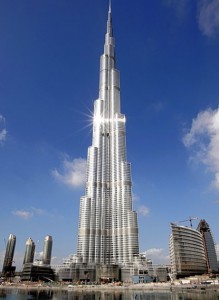By Peter Bill www.thisislondon.co.uk
You only get to ride halfway to the top of the world’s tallest tower in Dubai for your Ł20 ticket, despite the newly opened tourist experience being billed At the Top. Even so, take it. It sure beats the slow climb up the Empire State Building.

After an ear-popping 55-second ride, the lift opens onto the 124th-floor viewing platform. From 1400 feet up, you can gaze down in wonder at the hundreds of becalmed tower cranes and the dozens of half-finished buildings.
Gaze upwards and you can just see the top of the tapering silver tower. Then it is easy to see why the ruler of Abu Dhabi demanded his name be attached to the Burj Dubai, hastily renamed the Burj Khalifa just before it opened on 5 January. This was the price in kind demanded by Sheik Khalifa bin Zayed Al Nahyan for guaranteeing the $10 billion (Ł6.3 billion) debts of his profligate neighbour state.
About $2 billion is owed to British builders and consultants. Lord Mandelson is due to visit this month to press the ruler, Sheikh Mohammed bin Rashid Al Maktoum, to pay up. Good news. But two days ago, property agent CBRE reported bad news for developers, saying that office-leasing has more than halved and there are “few signs to suggest any imminent upturn”.
Even so, beyond the stalled projects, there are few visible signs of the debt crisis that hit the tiny Gulf state last November. The airport is busy. The traffic is heavy. The gigantic Dubai Mall, which sits by the tower, was teeming with shoppers last Friday evening. Bloomingdale’s opened this week. Primark, M&S, Waitrose and Debenhams are among the 1200 stores in a busy centre the size of 50 football fields.
Two weeks ago there was a top-level government shake-up. The ruler’s uncle, Sheik Amhed bin Saeed, who is chief executive of the highly successful Emirates Airline, is taking a more central role. This has prompted “light at the end of the tunnel” headlines — something that property agents Jones Lang LaSalle agrees with.
Last week JLL issued a “glass half full” report, suggesting office rents in the central business district at least, were stabilising after a 44% fall. “Vacancy rates in CBD are less than 10%,” says Blair Hagkull, JLL managing director for the 100-strong Middle East office that sits in the shadow of the Burj Khalifa.
The Canadian says this year will be one of “selective stability”. “Companies still see Dubai as the regional hub for the Middle East. Prime office space has now become affordable and attractive to these prospective tenants. We are now seeing a return of interest.”
But the JLL report also shows that 20 million square feet of office space planned to be complete between 2009 and 2011 has simply evaporated. That statistic helps explain why, when you look down from the top of the Burj Khalifa, you don’t just see tower cranes at rest; the outer landscape is pockmarked with holes in the ground.














